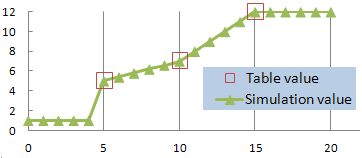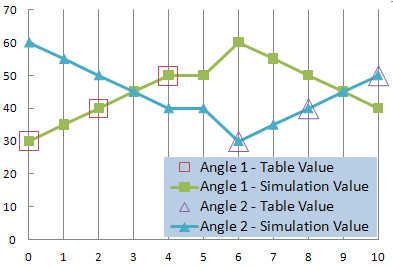Interpolation of Time Increments | ||||||
|
| |||||
Time and command values can be managed using a value table. A value table is a design table for law excitations or a recorded excitation table for recorded excitations.
If the time parameter range in your value table does not correspond directly to the time parameter increments in the kinematics scenario, the following rules are enforced to determine the command values:
- If the smallest time increment in the value table is larger than the initial time increment in the simulation, the mechanism will remain in its nominal position until the simulation reaches the smallest increment in the table.
- If the simulation extends past the final time increment in the value table, the final command value specified in the value table is enforced until the simulation is over.
- If the time increments in the value table do not correspond exactly to the time increments in the kinematics simulation, the simulation command value is interpolated based on the two closest time parameters in the value table.
The interpolation of command values works only if a value is defined for both the previous and subsequent increments in the value table. This may not be the case for some interdependent commands in which values are defined for different commands between one increment and the next; see examples below for more details.
![]()
Example of a Single Command
In this example, the command values in the value table are defined in five-second increments, starting at 5 seconds. However, the simulation runs in one-second increments starting at 0 seconds.
| Excitation.1\Time(sec) | 5 | 10 | 15 |
| Excitation.1\Length(mm) | 5 | 7 | 12 |

- From 0 to 4 seconds the command remains at its nominal value (in this case, 1).
- At 5, 10, and 15 seconds the command value matches the value specified in the table. Between each of these increments, the command value is interpolated linearly.
- After 15 seconds the command value remains at the final value specified in the value table.
![]()
Example of Interdependent Commands
In this example, the value table defines two interdependent commands: the value of one angle can be determined in the mechanism based on the value of the other angle. The value table defines values in two-second increments, while the simulation runs in one-second increments.
| Excitation.1\Time(sec) | 0 | 2 | 4 | 6 | 8 | 10 |
| Excitation.1\Angle(deg) | 30 | 40 | 50 | |||
| Excitation.2\Angle(deg) | 30 | 40 | 50 |

- From 0 to 4 seconds, the values for Angle 1 match the values specified in the value table; values for odd-numbered seconds are interpolated linearly. The values for Angle 2 are calculated in the mechanism based on the values of Angle 1.
- At 5 seconds, the command values cannot be interpolated because the assigned values in the value table switch from Angle 1 to Angle 2 during this interval. For the Angle 1 command, an upper bound for calculating the interpolation is missing; for the Angle 2 command, a lower bound for calculating the interpolation is missing. Instead, the mechanism remains at its last well-defined configuration.
- From 6 to 10 seconds, the values for Angle 2 match the values specified in the value table; values for odd-numbered seconds are interpolated linearly. The values for Angle 1 are calculated in the mechanism based on the values of Angle 2.